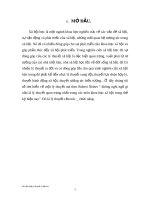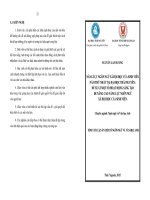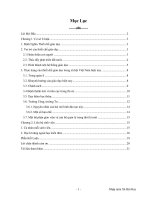TIỂU LUẬN NGÔN NGỮ XÃ HỘI HỌC
Bạn đang xem bản rút gọn của tài liệu. Xem và tải ngay bản đầy đủ của tài liệu tại đây (266.08 KB, 11 trang )
HUE UNIVERSITY
INSTITUTE OF OPEN EDUCATION
AND INFORMATION TECHNOLOGY
ENGLISH LANGUAGE
🙤🙤🙤
SOCIOLINGUISTIC PROJECT
Lecturer: PhD.Trần Thuần
Student: Nguyễn Thị Hồng Ngọc
Date of birth: 13/10/1992
Student’s code: 7052900468
Class: Nghệ An 6
TOPIC 2: Examine the differences between the English spoken in
Boston and the English spoken in the southern area of the United
States. Why do you think there is such dialectal evidence?
Nghệ An, July 2023
I. INTRODUCTION
1
The idea of writing about English dialects came first from my interest in
sociolinguistics and particularly the English language. Indeed, having fallen in
love with the language of Shakespeare since my childhood, the disparity of the
way English is spoken has always amazed me. At the beginning of my studies of
this wonderful language, hearing the English of a native speaker would puzzle
me because I would not figure out any word of the speech, which was odd, for
the speech of some native Black English speakers would sound familiar to me.
Later, thanks to sociolinguistics classes, I found out that regions and societies
favor the difference in the way a language is spoken. It immediately turned out
to be a need and a wish for me to explore the diversity of English dialects. One
of the main purposes of this study is to bring an enlightened view on the
conception of dialects in sociolinguistics. Given that, dialect is one of the most
confusing terms in sociolinguistics and it usually stands for a cause of
disagreement even between linguists. For example, it is very hard to delineate
the concept of dialect and language for they are not represented in a clear-cut
way in the sense that one can talk about American English and British English,
but it is linguistically difficult to say where people stop speaking American
English and where they start speaking British English. Besides, I chose to write
on this subject to bring an answer to the question of whether certain dialects are
more valuable than others. Indeed, very often speakers of certain dialects
(especially the standard dialects speakers) are thought to speak in a correct way
while speakers of other dialects (generally the non-standard users) are
stereotyped as being vulgar and incorrect. Therefore, it would be interesting to
conduct a scientific survey to prove or refute these common assertions. The
hugeness of English and its adoption by new nations in today’s world has
rendered its varieties more complex. Because the more people are regionally
distant and socially different, the more the language is affected, therefore it is
worthwhile to classify the different ways it is spoken and identify the very
dialects, which compose the language.
2
Language is a fascinating and ever-evolving aspect of human
communication, shaped by the diverse cultures, histories, and geographical
regions in which it is spoken. Within a single language, such as English, we find
a multitude of dialects that exhibit unique linguistic features and variations. In
the United States, two prominent regional dialects that stand out are Boston
English and Southern United States English. These dialects not only
differentiate themselves from Standard American English but also from each
other, reflecting the distinct linguistic landscapes of their respective regions.
II. DIFFERENCES
The English spoken in Boston and the southern area of the United States
exhibit distinct dialectal differences. These variations can be attributed to
several factors, including historical, cultural, and geographic influences.
2.1 Historical Factors:
The settlement patterns in these regions played a significant role in
shaping their dialects. Boston was one of the earliest English settlements in
North America and had a strong influence from the Puritans who migrated there
in the 17th century. Their speech patterns, vocabulary, and pronunciation left a
lasting impact on the local dialect, known as the Boston accent.
In the southern United States, the dialects have been influenced by
various historical events, such as the colonization of the region by English
speakers from different backgrounds. The settlement of the southern states was
primarily driven by English, Scottish, and Irish immigrants, who brought their
distinct linguistic features, contributing to the formation of unique dialectal
characteristics.
2.2. Cultural Factors
Cultural factors, including social norms, traditions, and interactions, can
also shape dialectal differences. In Boston, a long-standing emphasis on
3
education and intellectualism has influenced the local speech patterns. The
prestigious universities in the area, such as Harvard and MIT, have contributed
to a distinct accent associated with educated speech in the region.
In the southern United States, cultural factors such as a strong sense of
regional identity and a slower pace of life have influenced the local dialects. The
southern dialects often feature a slower and more relaxed speech tempo, as well
as distinct vocabulary and idiomatic expressions associated with Southern
culture.
2.3. Geographic Factors
The physical geography of an area can also contributes to dialectal
differences. Boston's location in the northeastern part of the United States
exposes it to the influence of other nearby dialects, such as the New York
accent. The proximity to major cities and transportation routes facilitates
linguistic contact and exchange, leading to shared features and influences
between neighboring regions.
In the southern United States, the vast and diverse geography contributes
to regional variations in dialect. The Southern dialects differ between states and
even within different parts of the same state. This variation can be attributed to
factors such as settlement patterns, isolation due to geographic features like
mountains or swamps, and the historical presence of African American
Vernacular English (AAVE) in some areas.
The English spoken in Boston and the southern area of the United States
exhibit notable dialectal differences in terms of pronunciation, vocabulary,
grammar, and intonation. Here are some key contrasts:
2.4. Pronunciation
Boston: The Boston accent is characterized by distinct vowel sounds,
such as the non-rhotic "r" (dropping the "r" sound at the end of words), the "aw"
4
sound becoming "ah" (e.g., "car" pronounced as "cah"), and the elongation of
certain vowel sounds.
Southern US: The Southern accent often features distinct vowel sounds,
such as the "a" sound becoming more nasalized (e.g., "cat" pronounced as
"caat"), the "i" sound becoming more diphthongized (e.g., "ride" pronounced as
"rahed"), and the presence of a "drawl" or a slower, elongated speech pattern.
2.5. Vocabulary
Boston: The Boston dialect includes some unique vocabulary, influenced
by the city's history and cultural context. For example, "wicked" is commonly
used as an intensifier meaning "very," and "rotary" is used instead of
"roundabout" to refer to traffic circles.
Southern US: The Southern dialect has its own set of vocabulary,
influenced by regional history, agriculture, and cultural factors. Terms like
"y'all" (you all), "fixin' to" (getting ready to), and "bless your heart" (a phrase
with various meanings depending on context) are commonly heard in Southern
speech.
2.6. Grammar
Boston: The Boston dialect exhibits some distinct grammatical features,
including the use of the present perfect tense with "be" instead of "have" (e.g., "I
am done my homework" instead of "I have done my homework").
Southern US: The Southern dialect may include grammatical features
such as the use of double modals (e.g., "might could" or "might can" instead of
"might be able to") and the use of "fixing to" or "going to" interchangeably to
express future actions.
2.7. Intonation and Expressions
Boston: The Boston accent often features a distinctive intonation pattern,
known as "Boston rising" or "High Rising Terminal," where statements end with
5
a rising pitch. Certain expressions and phrases are also characteristic of Boston
speech, such as "park the car in Harvard Yard" (to demonstrate the accent's
unique vowel sounds).
Southern US: The Southern accent is known for its melodic and slower
pace of speech. Expressions like "bless your heart," "y'all come back now, ya
hear," and "howdy" are commonly associated with Southern speech patterns.
The dialectal evidence between Boston and the southern area of the
United States can be attributed to a combination of historical, cultural, and
geographic factors:
2.8. Historical Settlement Patterns
SubsequentEnglish settlement in Boston by Puritans and subsequent
waves of immigration from different regions shaped the unique Boston accent.
In the southern states, settlement by English, Scottish, and Irish immigrants, as
well as the historical influence of African American Vernacular English
(AAVE), contributed to the formation of distinct Southern dialects.
2.9. Cultural and Social Influences
The cultural and social aspects of each region influenced the
development of their respective dialects. Boston's intellectual and academic
focus, influenced by the presence of prestigious universities, contributed to its
distinct accent. In the Southern US, the region's history, traditions, and social
dynamics contributed to the formation of a unique dialect that reflects the
cultural identity and values of the area.
2.10. Geographic Isolation and Interactions
Geographic factors, such as isolation or proximity to other regions,
impact linguistic development. Boston's proximity to other East Coast cities,
like New York, allows for linguistic exchange and shared features. In contrast,
the vast and diverse geography of the southern United States, with its varying
6
degrees of isolation, has led to regional variations in dialect within the Southern
accent.
III. CONCLUSION
In summary, the differences between the English spoken in Boston and
the southern area of the United States can be traced back to a combination of
historical, cultural, and geographic influences. These factors have shaped the
speech patterns, vocabulary, and pronunciation in each region, leading to the
distinct dialectal evidence observed today. The examination of Boston English
and Southern United States English reveals a fascinating array of dialectal
differences rooted in phonology, grammar, lexicon, historical factors, and
sociolinguistic dynamics. These dialects showcase the diverse linguistic
landscape within the United States, reflecting the historical, cultural, and social
influences that have shaped them. Phonological distinctions between Boston
English and Southern United States English encompass the presence or absence
of rhoticity, vowel pronunciation variations, and specific sound mergers.
Grammatical differences involve verb conjugation patterns, unique syntactic
features, and variations in tense and aspect expressions. Lexical variations
highlight region-specific vocabulary, cultural influences, and historical
loanwords. The historical and sociolinguistic factors surrounding these dialects
shed light on their development and differentiation. Settlement patterns,
immigration, migration, and regional identities have all contributed to the
linguistic diversity observed within Boston English and Southern United States
English. Understanding these factors enriches our comprehension of language
variation and the cultural contexts in which these dialects have evolved.
Language attitudes and perceptions shape how Boston English and Southern
United States English are perceived within society. Linguistic stereotypes,
prejudices, and notions of prestige influence the social dynamics surrounding
7
these dialects. Efforts to challenge stigmatization and promote linguistic
diversity are crucial for fostering inclusivity and respect for all dialects.
Language change and maintenance are ongoing processes in both dialects.
Internal and external factors drive language change, while language
maintenance efforts aim to preserve regional identities and linguistic heritage.
Balancing language evolution and the preservation of core dialectal features
contributes to a vibrant linguistic landscape that respects the historical and
cultural significance of Boston English and Southern United States English.
Both Boston English and Southern United States English are subject to
linguistic stereotypes and prejudices. These stereotypes often stem from cultural
and media representations, which can perpetuate biased views about the
intelligence, education, or social status of speakers. Boston English, with its
distinct accent and vocabulary, has been subject to stereotypes portraying
Bostonians as unsophisticated or uneducated. Media portrayals and caricatures
of the "Boston accent" have sometimes reinforced these negative stereotypes,
even though many highly educated individuals speak the dialect. Similarly,
Southern United States English has been subject to stereotypes that associate it
with lower education, backwardness, or unintelligence. Media portrayals often
depict Southern accents and dialects in ways that reinforce these negative
perceptions, disregarding the linguistic diversity and complexity within the
region. Language attitudes also affect the perceived prestige and stigmatization
of dialects. Standard American English, which aligns more closely with General
American pronunciation and grammar, is often regarded as the standard or
prestigious dialect in the United States.
In this context, both Boston English and Southern United States English
can be stigmatized as non-standard or colloquial. However, it is important to
recognize that stigmatization varies among different social groups and contexts.
Within their respective regions, these dialects hold cultural significance and can
be valued as markers of regional identity and authenticity.
8
Moreover, language attitudes can change over time. Efforts to challenge
linguistic prejudices and promote linguistic diversity have gained traction in
recent years. Movements advocating for the acceptance and celebration of
regional accents and dialects aim to counter linguistic stigmatization and
promote inclusivity.
The impact of language attitudes and perceptions on Boston English and
Southern United States English underscores the importance of recognizing and
challenging linguistic biases. Embracing linguistic diversity fosters a more
inclusive and equitable society, where all dialects are respected and valued for
their cultural and regional significance.
Both Boston English and Southern United States English are subject to
linguistic stereotypes and prejudices. These stereotypes often stem from cultural
and media representations, which can perpetuate biased views about the
intelligence, education, or social status of speakers. Boston English, with its
distinct accent and vocabulary, has been subject to stereotypes portraying
Bostonians as unsophisticated or uneducated. Media portrayals and caricatures
of the "Boston accent" have sometimes reinforced these negative stereotypes,
even though many highly educated individuals speak the dialect.
Similarly, Southern United States English has been subject to stereotypes
that associate it with lower education, backwardness, or unintelligence. Media
portrayals often depict Southern accents and dialects in ways that reinforce these
negative perceptions, disregarding the linguistic diversity and complexity within
the region.
In conclusion, the study of Boston English and Southern United States English
provides valuable insights into the rich tapestry of language variation within the
United States. These dialects not only showcase the linguistic diversity of the
nation but also reflect the complex interplay of historical, sociolinguistic, and
cultural factors that have shaped them. Appreciating and embracing this
9
linguistic diversity fosters cultural understanding promotes inclusivity, and
enriches our knowledge of language evolution and social dynamics.
10
REFERENCE MATERIALS
1. Labov, W. (2010). Principles of Linguistic Change: Cognitive
and Cultural Factors (Vol. 3). John Wiley & Sons.
2. Wolfram, W., & Schilling-Estes, N. (2006). American English:
Dialects and Variation. Blackwell Publishing.
3. Montgomery, M. B., & Thomas, E. R. (Eds.). (2013). Language
and Linguistics in Context: Readings and Applications for
Teachers (2nd ed.). Routledge.
4. Hall, R. A., & Bucholtz, M. (Eds.). (2019). The Oxford
Handbook of Sociolinguistics. Oxford University Press.
5. Labov, W., Ash, S., & Boberg, C. (2006). The Atlas of North
American English: Phonetics, Phonology, and Sound Change.
Walter de Gruyter.
11









